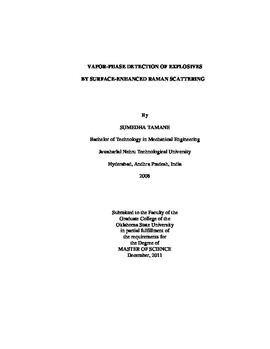| dc.contributor.author | Tamane, Sumedha | |
| dc.date.accessioned | 2014-04-17T19:54:13Z | |
| dc.date.available | 2014-04-17T19:54:13Z | |
| dc.date.issued | 2011-12-01 | |
| dc.identifier.uri | https://hdl.handle.net/11244/10074 | |
| dc.description.abstract | In the present work, we employ "nanometal-on-semiconductor" SERS substrates to detect various explosives including TNT, PETN, RDX, and TNB in vapor phase at concentrations on the order of few ppb. The SERS substrates were prepared by a novel process, where a monolayer of surfactant-free Ag nanoparticles was reduced on a Si thin film. Our work also targets a clear understanding of the factors, which so far have limited vapor phase SERS of the explosives. We have identified three major challenges: i) low vapor pressure of explosives at room temperature; ii) weak adsorption of the explosives on Ag nanostructures accounting for easy desorption even under low laser excitation; iii) photochemical decomposition of the explosive under the Raman. The present work also reveals the different adsorption configurations of TNT on Ag nanoparticles using SERS selection rules. The different adsorption configurations are associated with different desorption rates or decomposition rates during the SERS acquisition. We understand that desorption and decomposition of explosives are the major reasons, which have hindered SERS of explosives in vapor phase; previously. Despite the transient nature of the SERS spectrum, we show a reproducible signal is obtainable for 10 s integration. SERS of TNT and other explosives investigated in this study shows reproducible spectral deviations from Raman. This is attributed to chemisorption-induced electron transfer between the TNT molecule and the metal that alters the electron density distribution over the molecule. The nanoparticle temperature measured using Raman scattering as 27 C (close to room temperature) suggests that no laser induced heating occurs during our SERS acquisitions and the laser induced decomposition of TNT is a photochemical effect.</ | |
| dc.format | application/pdf | |
| dc.language | en_US | |
| dc.publisher | Oklahoma State University | |
| dc.rights | Copyright is held by the author who has granted the Oklahoma State University Library the non-exclusive right to share this material in its institutional repository. Contact Digital Library Services at lib-dls@okstate.edu or 405-744-9161 for the permission policy on the use, reproduction or distribution of this material. | |
| dc.title | Vapor-phase Detection of Explosives by Surface-enhanced Raman Scattering | |
| dc.type | text | |
| osu.filename | Tamane_okstate_0664M_11702.pdf | |
| osu.college | Engineering, Architecture, and Technology | |
| osu.accesstype | Open Access | |
| dc.description.department | Mechanical & Aerospace Engineering | |
| dc.type.genre | Thesis | |
| dc.subject.keywords | explosive | |
| dc.subject.keywords | surface-enhanced raman scattering | |
| dc.subject.keywords | trace level detection | |
| dc.subject.keywords | vapor phase | |
